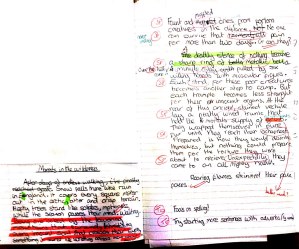 Image: @jasonramasami
Image: @jasonramasami
Not for the first time, a trip to the supermarket has given me cause for thought about my English teaching. This time the catalyst was a shopping list written for me by my partner. Even though it was good of her to save me the effort, I found it extremely hard to follow. The vegetables, for instance, were not all listed together. It was only upon arrival at the baby wipes that I realised that I had missed the ‘parsnips’ (scribbled at the bottom), which left me with no other option but to traipse all the way over to the vegetables near the entrance again …
All this got me thinking about the way students and teachers plan for extended writing. You see, when I write my own list I am a much more efficient negotiator of supermarket aisles than I am when following somebody else’s. The act of writing a shopping list is really a plan of action, a cognitive support written to help us cope with the human and grocery overload of Morrisons on a Saturday afternoon. Without a list, we are likely to forget vital items and walk round in aimless circles. When we write a list ourselves we also think through the process of shopping, not just the items we need.
This phenomenon also explains why teaching children how to organise and structure their ideas is such a key aim of writing instruction; once a plan is in place, a child can concentrate on the finer details of grammar and ideas, instead of worrying about what they will write next. However, I do wonder whether I have often scaffolded too much and in doing so prevented children from learning the process of planning.
In my early years of teaching, I was often guilty of producing writing frames that looked a little like this:
Paragraph 1
Start with a discourse marker.
What did the quote ‘We are members of one body’ mean?
Why do you think ‘body’ was a good metaphor for Priestley to use?
How do you think this links to Priestley’s overall message about socialism?
What impact would this have had on Priestley’s 1945 audience?
And so on …
This would go on for a number of paragraphs – I even remember one or two double-sided plans! Of course, I was not teaching students how to structure and develop ideas; they were simply learning to ‘writing by numbers’. In fact, like a shopping list written by someone else, it would confuse as often as it would guide.
The trouble with this kind of scaffolding, however, is that when all the dots are joined together and the misunderstandings ironed out, it can lead to an end-product with a veneer of sophistication, even though the writer has had to engage in little independent thought to get there. This is problematic, not least when you consider Professor Robert Coe’s suggestion that “Learning happens when you have had to think hard.” It is unwise to confuse the quality of the end product with the quality of learning; they are not always the same thing. Learning needs to be carried forward and applied in new contexts, otherwise it is meaningless. It is very possible, therefore, that a less-refined final product (planned and organised by the student themselves) could lead to more genuine learning than the polished product of too much scaffolding.
This is why in an age of hyper-accountability coursework is such a bad idea: how do we know whether a successful final piece is the product of student learning or the result of extensive teacher scaffolding?
So how do we strike a balance between teacher guidance and student thinking?
Unfortunately, there is no easy answer. I try to take students through the planning process by modelling each step and then allowing students to practise that step. This way, they do a lot of the thinking, yet I can shape the direction as necessary.
I am about to teach my my year 9s how to write a comparative poetry essay for the first time. This is the structure I have planned:
1. Teach both poems so that students understand content, poetic features and poet’s themes/ideas etc.
2. Model how to find points for comparison. Students independently find and list their own comparisons, e.g. Both poems explore the idea of the brutality of the battlefield through the personification of nature. They share and we pare down to the best.
3. Model how to organise points into a coherent essay structure. Students independently order their points. (I have created a simple grid for this with 5/6 rows, one for each paragraph, and two columns, one for each poem.)
4. Model how to add supporting evidence and analysis (in note form) to the plan. Students independently do the same, but using their evidence, not mine.
5. Model how to structure and write a comparative paragraph. Students micro-practise writing a paragraph independently, once again using their own points, not mine.
6. Students write extended essay in exam conditions.
As students get older and become more proficient they need fewer steps. Many of these stages can be skipped once the habits have become embedded. For example, as my GCSE students head towards their final exams, I regularly throw exam-style questions at them and give them 5-minutes to create a plan.
Planning extended writing is one of the most important self-regulation and metacognitive skills we can explicitly teach young people. Ultimately, they must learn to scaffold their own work – and they cannot do that if their teacher always does it for them.
Related post:

























